Polysaccharide Hydrogels with Waste Wool Fibre as Matrix for Potential Use as CRF Fertiliser
Abstract
1. Introduction
2. Results and Discussion
2.1. Analysis of the Swelling Degree
2.2. Microscopic and SEM Observations
2.3. Thermogravimetric Analysis
2.4. Differential Scanning Calorimetry Analysis
2.5. Water Retention Study
3. Materials and Methods
4. Conclusions
- Too high a concentration of cross-linker results in a compact hydrogel structure that is unable to swell repeatedly;
- Wool fibres disrupt the structure of the hydrogel network, resulting in weaker swelling, but the beneficial release of water into the soil lasts longer with a high fibre addition;
- Thermal analysis and, in particular, differential scanning calorimetry (DSC) results allow the performance of the material to be accurately predicted and the bonding of the water to the material to be determined. Thermal analysis has shown that, due to the large addition of fibres, the evaporation of water from the hydrogel is impaired, and the process starts at higher temperatures. DSC studies have determined how water is bound in hydrogels. The addition of fibres causes the ratio of freezing and non-freezing water to change. For a large fibre addition, the amount of freezing water is 3 times higher compared to the hydrogel matrix. This can be related to soil water retention results, where the same hydrogels with a high fibre addition (24 and 35%) performed almost 1.5 times better than the hydrogel alone, and 2 times better than the reference sample (soil).
Author Contributions
Funding
Institutional Review Board Statement
Informed Consent Statement
Data Availability Statement
Conflicts of Interest
References
- Delabre, I.; Rodriguez, L.O.; Smallwood, J.M.; Scharlemann, J.P.W.; Alcamo, J.; Antonarakis, A.S.; Rowhani, P.; Hazell, R.J.; Aksnes, D.L.; Balvanera, P.; et al. Actions on Sustainable Food Production and Consumption for the Post-2020 Global Biodiversity Framework. Sci. Adv. 2023, 7, eabc8259. [Google Scholar] [CrossRef] [PubMed]
- Rosa, L.; Chiarelli, D.D.; Rulli, M.C.; Dell’Angelo, J.; D’Odorico, P. Global Agricultural Economic Water Scarcity. Sci. Adv. 2023, 6, eaaz6031. [Google Scholar] [CrossRef] [PubMed]
- Pretty, J. Intensification for Redesigned and Sustainable Agricultural Systems. Science 2018, 362, eaav0294. [Google Scholar] [CrossRef] [PubMed]
- Krein, D.D.C.; Rosseto, M.; Cemin, F.; Massuda, L.A.; Dettmer, A. Recent Trends and Technologies for Reduced Environmental Impacts of Fertilizers: A Review. Int. J. Environ. Sci. Technol. 2023, 20, 12903–12918. [Google Scholar] [CrossRef]
- Molik, E.; Szatkowski, P.; Flis, Z.; Suchorowiec, K.; Szczepanik, E.; Niemiec, M.; Komorowska, M.; Matusevičius, P. Tradition and Innovative in the Protection of the Natural Environment of Mountain Regions. Acta Sci. Pol. Form. Circumiectus 2023, 22, 33–40. [Google Scholar] [CrossRef]
- Niu, C.; Lin, Z.; Fu, Q.; Xu, Y.; Chen, Y.; Lu, L. An Eco-Friendly Versatile Superabsorbent Hydrogel Based on Sodium Alginate and Urea for Soil Improvement with a Synchronous Chemical Loading Strategy. Carbohydr. Polym. 2024, 327, 121676. [Google Scholar] [CrossRef]
- Sabadini, R.C.; Fernandes, M.; Bermudez, V.D.Z.; Pawlicka, A.; Silva, M.M. Hydrogels Based on Natural Polymers Loaded with Bentonite and/or Halloysite: Composition Impact on Spectroscopic, Thermal, and Swelling Properties. Molecules 2024, 29, 131. [Google Scholar] [CrossRef]
- Wu, J.; Yang, H.; Hou, C.; Guan, H.; Gu, S.; Yin, Y.; Jing, H.; Wang, Y.; Wang, M. Preparation of an Attapulgite-Modified Composite Hydrogel and Application in an Environmentally Responsive Green Fertilizer. ACS Appl. Polym. Mater. 2023, 5, 10217–10225. [Google Scholar] [CrossRef]
- Yuan, W.; Li, S.; Guan, H.; Zhang, S.; Zhang, Y.; Zhang, M.; Yu, Y.; Chen, X. Preparation and Properties of a Novel Biodegradable Composite Hydrogel Derived from Gelatin/Chitosan and Polylactic Acid as Slow-Release N Fertilizer. Polymers 2023, 15, 997. [Google Scholar] [CrossRef]
- Jabrail, F.H.; Mutlaq, M.S.; Al-Ojar, R.K. Studies on Agrochemical Controlled Release Behavior of Copolymer Hydrogel with PVA Blends of Natural Polymers and Their Water-Retention Capabilities in Agricultural Soil. Polymers 2023, 15, 3545. [Google Scholar] [CrossRef]
- Tiamwong, S.; Yukhajon, P.; Noisong, P.; Subsadsana, M.; Sansuk, S. Eco-Friendly Starch Composite Supramolecular Alginate–Ca2+ Hydrogel as Controlled-Release P Fertilizer with Low Responsiveness to Multiple Environmental Stimuli. Gels 2023, 9, 204. [Google Scholar] [CrossRef] [PubMed]
- Sabadini, R.C.; Fernandes, M.; de Zea Bermudez, V.; Pawlicka, A.; Silva, M.M. Eco-Friendly Superabsorbent Hydrogels Based on Starch, Gellan Gum, Citric Acid, and Nanoclays for Soil Humidity Control. J. Appl. Polym. Sci. 2022, 139, e52998. [Google Scholar] [CrossRef]
- Chen, Y.S.; Phang, S.W.; Shuib, A.S.; Tee, J.L. Release Behavior and Biodegradability of Controlled-Release Potassium Fertilizer Encapsulated in Starch–Alginate Matrix. Asia-Pac. J. Chem. Eng. 2023, 18, e2998. [Google Scholar] [CrossRef]
- Marchelli, F.; Rovero, G.; Curti, M.; Arato, E.; Bosio, B.; Moliner, C. An Integrated Approach to Convert Lignocellulosic and Wool Residues into Balanced Fertilisers. Energies 2021, 14, 497. [Google Scholar] [CrossRef]
- Bora, A.; Sarmah, D.; Karak, N. Cellulosic Wastepaper Modified Starch/Itaconic Acid/Acrylic Acid-Based Biodegradable Hydrogel as a Sustain Release of NPK Fertilizer Vehicle for Agricultural Applications. Int. J. Biol. Macromol. 2023, 253, 126555. [Google Scholar] [CrossRef]
- Merino, D.; Mansilla, A.Y.; Salcedo, M.F.; Athanassiou, A. Upcycling Orange Peel Agricultural Waste for the Preparation of Green Hydrogels as Active Soil Conditioners. ACS Sustain. Chem. Eng. 2023, 11, 10917–10928. [Google Scholar] [CrossRef]
- Das, D.; Bhattacharjee, S.; Bhaladhare, S. Preparation of Cellulose Hydrogels and Hydrogel Nanocomposites Reinforced by Crystalline Cellulose Nanofibers (CNFs) as a Water Reservoir for Agriculture Use. ACS Appl. Polym. Mater. 2023, 5, 2895–2904. [Google Scholar] [CrossRef]
- Zhang, F.; Chen, H.; Yang, H.; Zhao, S.; Zhang, Y.; He, Y.; Song, P.; Wang, R. Waste Feather Keratin Composited Geopolymer Hydrogels for Improving Plant Water Retention and N Nutrients Utilization. Colloids Surf. A Physicochem. Eng. Asp. 2024, 682, 132925. [Google Scholar] [CrossRef]
- Chen, H.; Gao, S.; Li, Y.; Xu, H.-J.; Li, W.; Wang, J.; Zhang, Y. Valorization of Livestock Keratin Waste: Application in Agricultural Fields. Int. J. Environ. Res. Public Health 2022, 19, 6681. [Google Scholar] [CrossRef]
- Szczepanik, E.; Szatkowski, P.; Molik, E.; Pielichowska, K. The Effect of Natural Plant and Animal Fibres on PLA Composites Degradation Process. Appl. Sci. 2024, 14, 5600. [Google Scholar] [CrossRef]
- Sun, Y.; Li, B.; Zhang, Y.; Dou, H.; Fan, W.; Wang, S. The Progress and Prospect for Sustainable Development of Waste Wool Resources. Text. Res. J. 2023, 93, 468–485. [Google Scholar] [CrossRef]
- Petek, B.; Marinšek Logar, R. Management of Waste Sheep Wool as Valuable Organic Substrate in European Union Countries. J. Mater. Cycles Waste Manag. 2021, 23, 44–54. [Google Scholar] [CrossRef]
- Komorowska, M.; Niemiec, M.; Sikora, J.; Gródek-Szostak, Z.; Gurgulu, H.; Chowaniak, M.; Atilgan, A.; Neuberger, P. Evaluation of Sheep Wool as a Substrate for Hydroponic Cucumber Cultivation. Agriculture 2023, 13, 554. [Google Scholar] [CrossRef]
- Broda, J.; Gawlowski, A.; Rom, M.; Kobiela-Mendrek, K. Utilisation of Waste Wool from Mountain Sheep as Fertiliser in Winter Wheat Cultivation. J. Nat. Fibers 2023, 20, 2200047. [Google Scholar] [CrossRef]
- Haque, A.N.M.A.; Naebe, M. Waste Wool Powder for Promoting Plant Growth by Moisture Retention. Sustainability 2022, 14, 12267. [Google Scholar] [CrossRef]
- Bradshaw, T.; Hagen, K. Wool Pellets Are a Viable Alternative to Commercial Fertilizer for Organic Vegetable Production. Agronomy 2022, 12, 1210. [Google Scholar] [CrossRef]
- Abdallah, A.M.; Ugolini, F.; Baronti, S.; Maienza, A.; Ungaro, F.; Camilli, F. Assessment of Two Sheep Wool Residues from Textile Industry as Organic Fertilizer in Sunflower and Maize Cultivation. J. Soil. Sci. Plant Nutr. 2019, 19, 793–807. [Google Scholar] [CrossRef]
- Zheljazkov, V.D. Assessment of Wool Waste and Hair Waste as Soil Amendment and Nutrient Source. J. Environ. Qual. 2005, 34, 2310–2317. [Google Scholar] [CrossRef]
- Rusu, A.G.; Popa, M.I.; Lisa, G.; Vereştiuc, L. Thermal Behavior of Hydrophobically Modified Hydrogels Using TGA/FTIR/MS Analysis Technique. Thermochim. Acta 2015, 613, 28–40. [Google Scholar] [CrossRef]
- Enev, V.; Sedláček, P.; Jarábková, S.; Velcer, T.; Pekař, M. ATR-FTIR Spectroscopy and Thermogravimetry Characterization of Water in Polyelectrolyte-Surfactant Hydrogels. Colloids Surf. A Physicochem. Eng. Asp. 2019, 575, 1–9. [Google Scholar] [CrossRef]
- Hackl, E.V.; Khutoryanskiy, V.V.; Tiguman, G.M.B.; Ermolina, I. Evaluation of Water Properties in HEA–HEMA Hydrogels Swollen in Aqueous-PEG Solutions Using Thermoanalytical Techniques. J. Therm. Anal. Calorim. 2015, 121, 335–345. [Google Scholar] [CrossRef]
- Pathak, T.S.; Yun, J.-H.; Lee, J.; Paeng, K.-J. Effect of Calcium Ion (Cross-Linker) Concentration on Porosity, Surface Morphology and Thermal Behavior of Calcium Alginates Prepared from Algae (Undaria Pinnatifida). Carbohydr. Polym. 2010, 81, 633–639. [Google Scholar] [CrossRef]
- Guan, Y.L.; Shao, L.; De Yao, K. A Study on Correlation between Water State and Swelling Kinetics of Chitosan-Based Hydrogels. J. Appl. Polym. Sci. 1996, 61, 2325–2335. [Google Scholar] [CrossRef]
- Azam, F.; Ahmad, F.; Ahmad, S.; Zafar, M.S.; Ulker, Z. Preparation and Characterization of Alginate Hydrogel Fibers Reinforced by Cotton for Biomedical Applications. Polymers 2022, 14, 4707. [Google Scholar] [CrossRef] [PubMed]
- Das, D.; Prakash, P.; Rout, P.K.; Bhaladhare, S. Synthesis and Characterization of Superabsorbent Cellulose-Based Hydrogel for Agriculture Application. Starch-Stärke 2021, 73, 1900284. [Google Scholar] [CrossRef]
- Huang, J.; Chen, L.; Huang, M.; Liu, M. Urea Intercalated Halloysite/Sodium Alginate Composite Hydrogels for Slow-Release Fertilizers. Appl. Clay Sci. 2023, 242, 107041. [Google Scholar] [CrossRef]
- Abg Ahmad, D.F.B.; Wasli, M.E.; Tan, C.S.Y.; Musa, Z.; Chin, S.-F. Eco-Friendly Cellulose Hydrogels as Controlled Release Fertilizer for Enhanced Growth and Yield of Upland Rice. Sci. Rep. 2023, 13, 20453. [Google Scholar] [CrossRef]
- Cursaru, B.; Stanescu, P.; Teodorescu, M. The States of Water in Hydrogels Synthesized from Diepoxy-Terminated Poly(Ethylene Glycol)s and Aliphatic Polyamines. UPB Sci. Bull. Ser. B 2010, 72, 99–114. [Google Scholar]
- Li, W.; Xue, F.; Cheng, R. States of Water in Partially Swollen Poly(Vinyl Alcohol) Hydrogels. Polymer 2005, 46, 12026–12031. [Google Scholar] [CrossRef]
- Zhang, K.; Luo, Y.; Li, Z. Synthesis and Characterization of a PH- and Ionic Strength-Responsive Hydrogel. Soft Mater. 2007, 5, 183–195. [Google Scholar] [CrossRef]

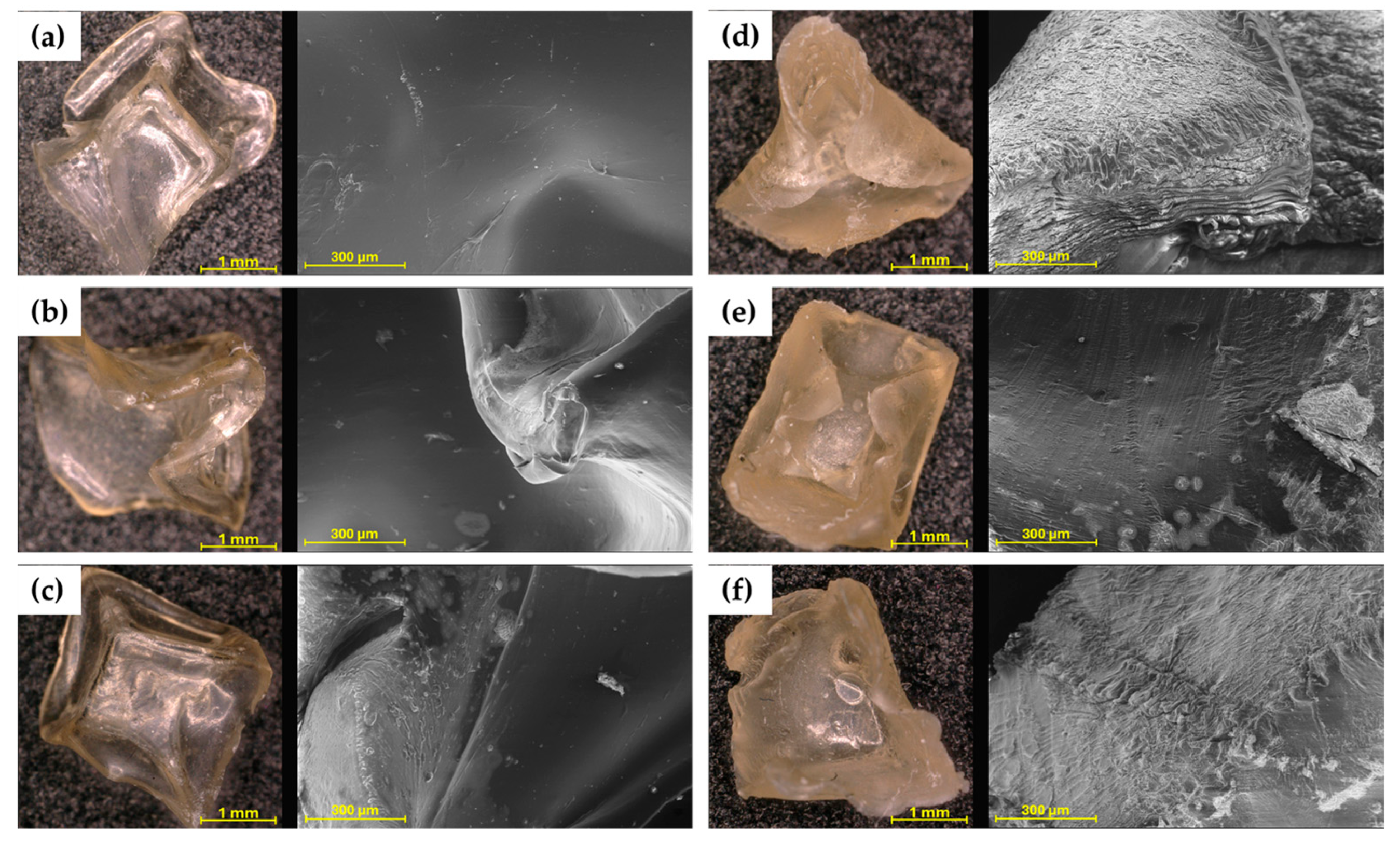
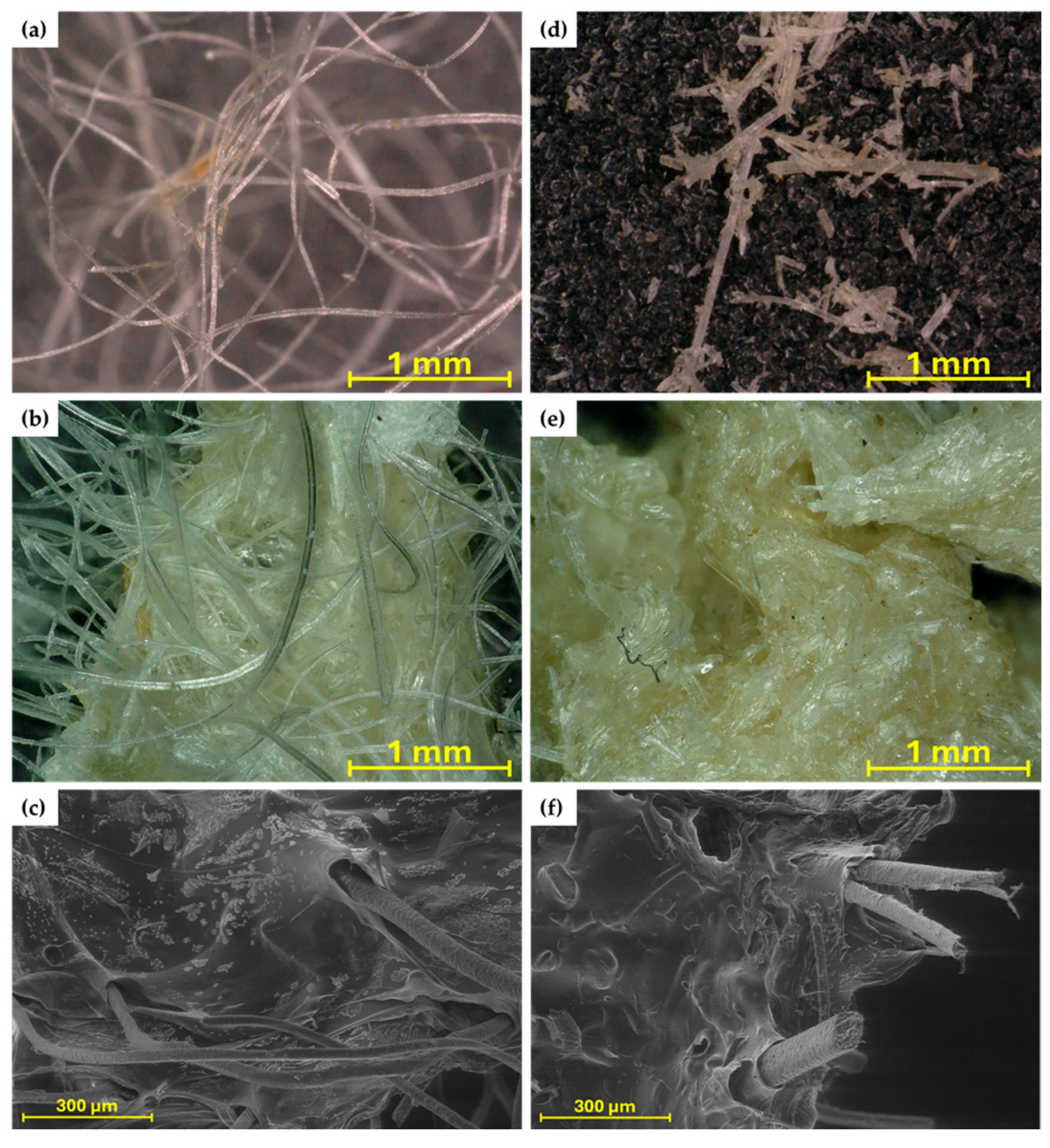
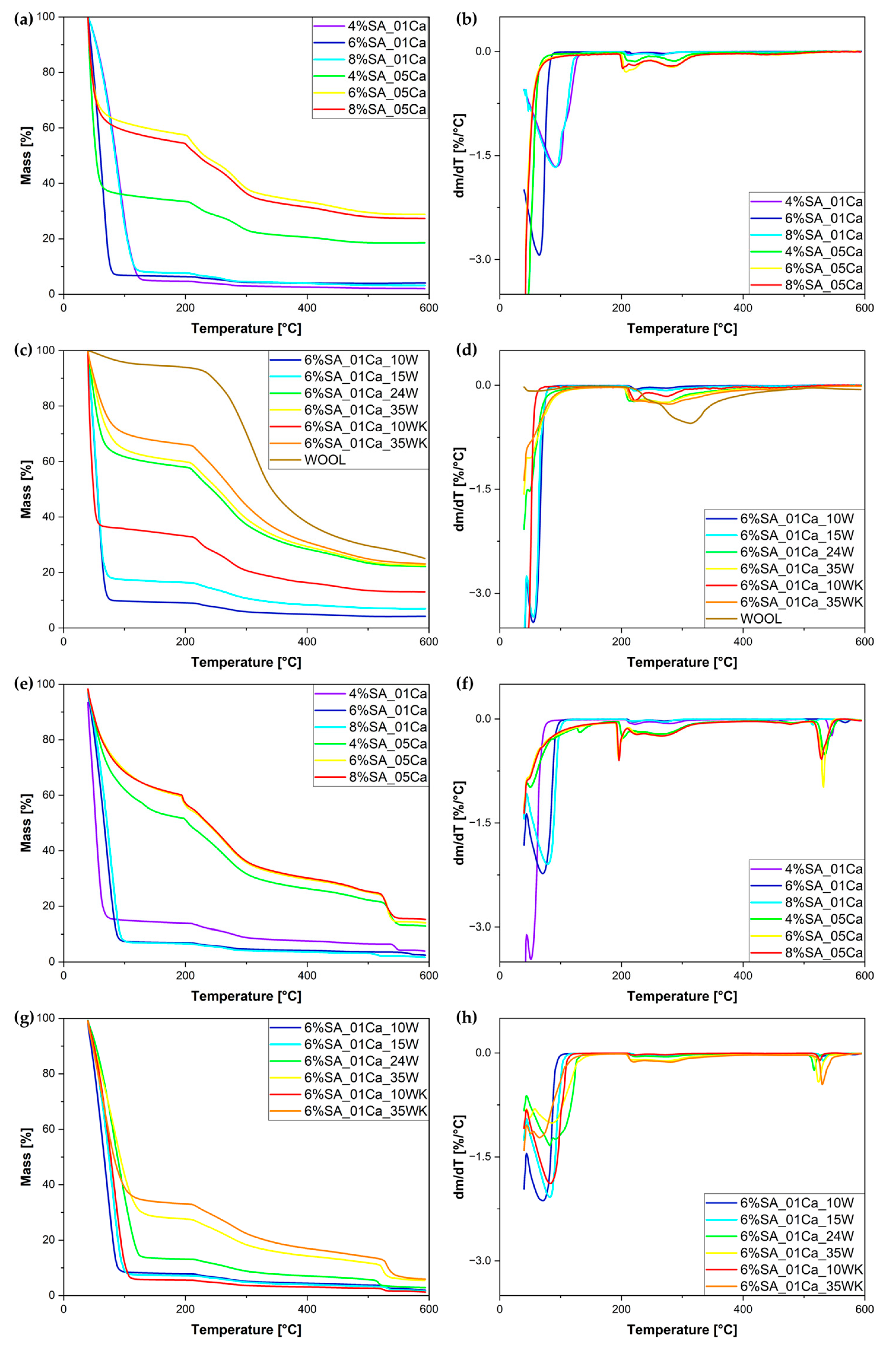
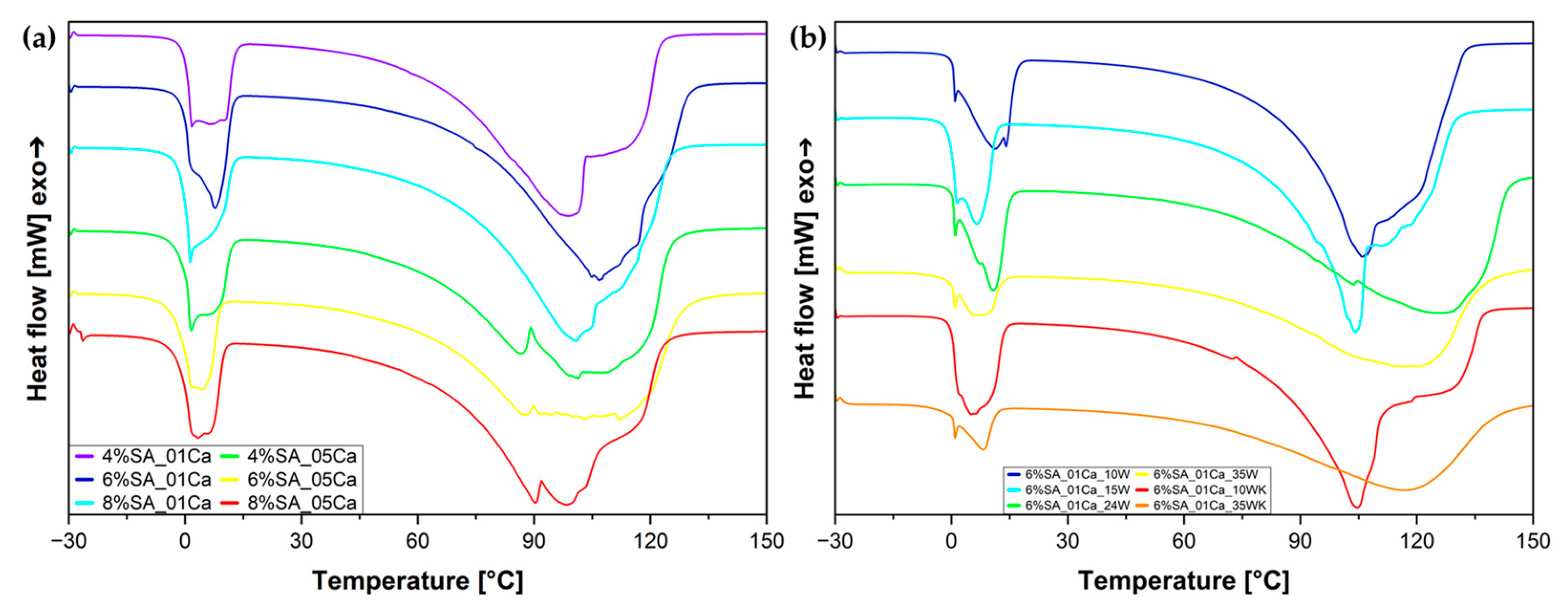
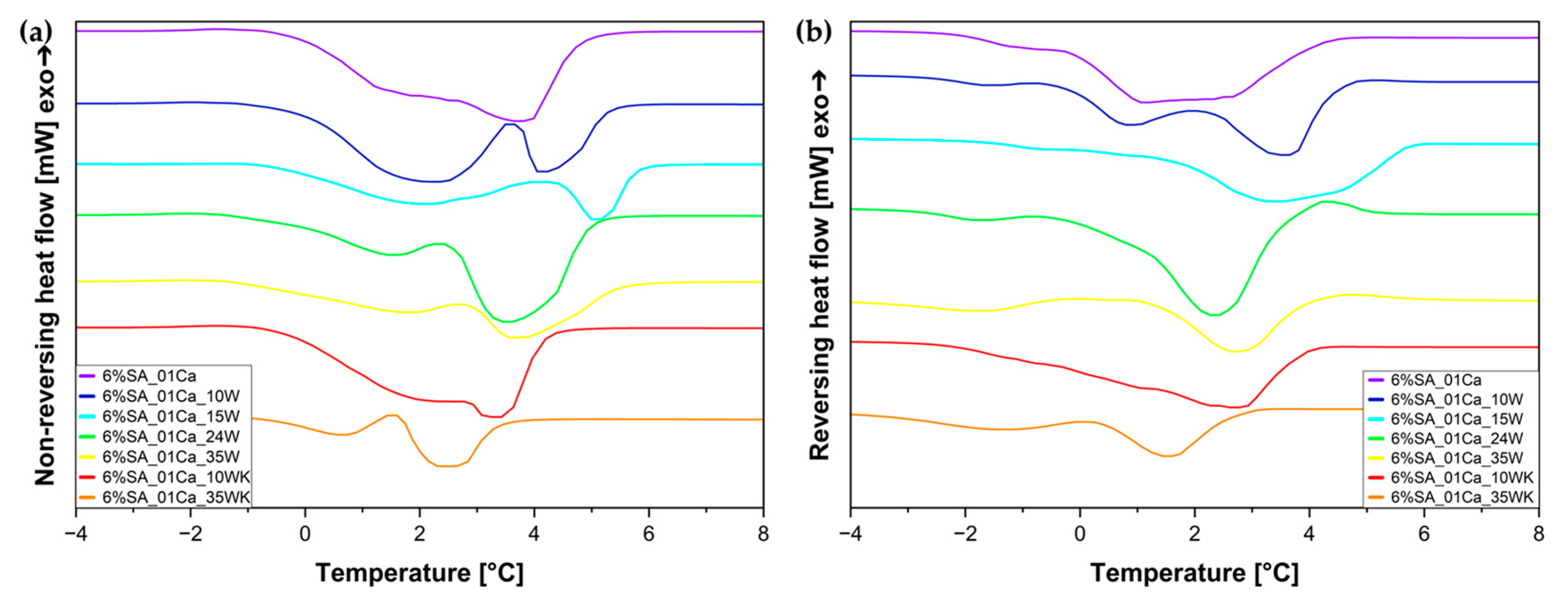
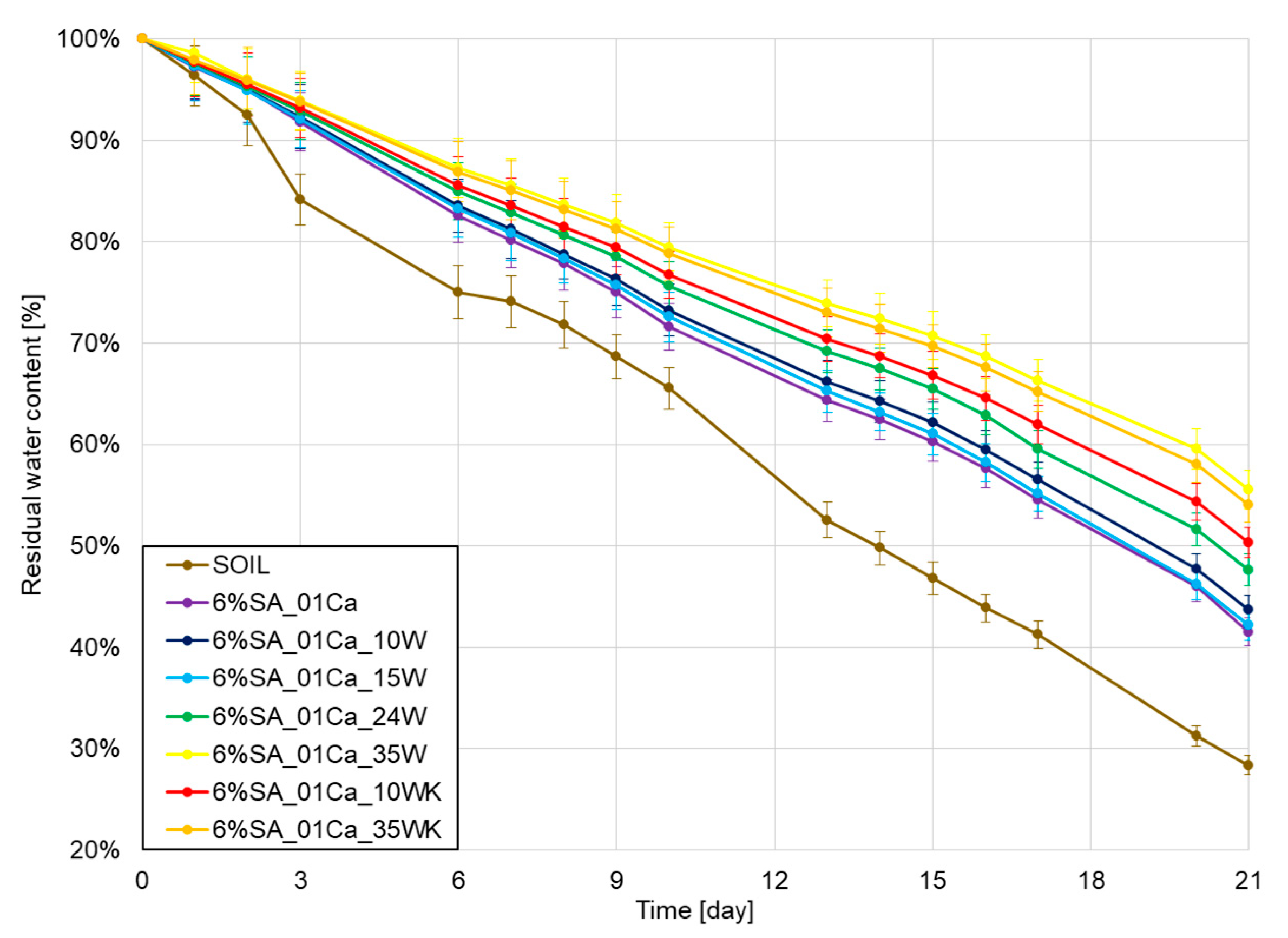
| Atmosphere | Sample | T1% [°C] | T3% [°C] | T5% [°C] | T20% [°C] | T50% [°C] | Wr [%] | T1,DTGmax | T2,onset | T2,DTGmax | T3,onset | T3,DTGmax |
|---|---|---|---|---|---|---|---|---|---|---|---|---|
| N2 | 4%SA_01Ca | 35 | 38 | 42 | 61 | 84 | 1.93 | 92 | 210 | 219 | - | - |
| 6%SA_01Ca | 32 | 32 | 33 | 43 | 58 | 3.44 | 66 | 211 | 222 | - | - | |
| 8%SA_01Ca | 35 | 38 | 42 | 60 | 84 | 3.09 | 93 | 207 | 215 | - | - | |
| 4%SA_05Ca | 39 | 40 | 40 | 42 | 51 | 16.91 | <40 | 207 | 220 | - | - | |
| 6%SA_05Ca | 40 | 40 | 40 | 43 | 211 | 26.27 | <40 | 203 | 208 | - | - | |
| 8%SA_05Ca | 40 | 40 | 40 | 43 | 196 | 25.04 | <40 | 200 | 202 | - | - | |
| Air | 4%SA_01Ca | 40 | 40 | 40 | 44 | 53 | 3.90 | 50 | 212 | 222 | 541 | 546 |
| 6%SA_01Ca | 40 | 40 | 41 | 51 | 66 | 2.43 | 70 | 214 | 220 | 558 | 568 | |
| 8%SA_01Ca | 40 | 40 | 42 | 54 | 71 | 1.67 | 79 | 210 | 270 | 509 | 514 | |
| 4%SA_05Ca | 40 | 40 | 42 | 58 | 204 | 12.86 | 50 | 197 | 202 | 523 | 528 | |
| 6%SA_05Ca | 40 | 40 | 42 | 64 | 235 | 14.03 | 41 | 193 | 195 | 530 | 531 | |
| 8%SA_05Ca | 40 | 41 | 43 | 63 | 237 | 15.18 | 42 | 194 | 197 | 523 | 529 |
| Atmosphere | Sample | T1% [°C] | T3% [°C] | T5% [°C] | T20% [°C] | T50% [°C] | Wr [%] | T1,DTGmax | T2,onset | T2,DTGmax | T3,onset | T3,DTGmax |
|---|---|---|---|---|---|---|---|---|---|---|---|---|
| N2 | 6%SA_01Ca_10W | 40 | 40 | 40 | 45 | 55 | 4.00 | 56 | 217 | 223 | - | - |
| 6%SA_01Ca_15W | 40 | 40 | 40 | 45 | 55 | 6.54 | 56 | 215 | 223 | - | - | |
| 6%SA_01Ca_24W | 40 | 40 | 40 | 50 | 232 | 21.20 | 50 | 208 | 220 | - | - | |
| 6%SA_01Ca_35W | 40 | 40 | 42 | 56 | 248 | 21.99 | <40 | 210 | 223 | - | - | |
| 6%SA_01Ca_10WK | 40 | 40 | 40 | 40 | 46 | 11.12 | <40 | 215 | 222 | - | - | |
| 6%SA_01Ca_35WK | 40 | 40 | 42 | 61 | 273 | 22.55 | <40 | 212 | 240 | - | - | |
| WOOL | 54 | 79 | 133 | 280 | 342 | 25.05 | 48 | 232 | 313 | - | - | |
| Air | 6%SA_01Ca_10W | 40 | 41 | 42 | 51 | 66 | 1.89 | 73 | 214 | 223 | 522 | 526 |
| 6%SA_01Ca_15W | 40 | 41 | 43 | 56 | 74 | 1.63 | 83 | 219 | 227 | 528 | 532 | |
| 6%SA_01Ca_24W | 40 | 43 | 46 | 64 | 88 | 2.84 | 82 | 220 | 273 | 513 | 516 | |
| 6%SA_01Ca_35W | 40 | 42 | 44 | 62 | 93 | 5.46 | 86 | 211 | 273 | 520 | 525 | |
| 6%SA_01Ca_10WK | 40 | 42 | 44 | 58 | 77 | 1.28 | 87 | 213 | 223 | 522 | 526 | |
| 6%SA_01Ca_35WK | 40 | 41 | 43 | 56 | 83 | 1.96 | 66 | 213 | 279 | 526 | 529 |
| Sample | Tm,s [°C] | Tm,e [°C] | Hendo [J/g] | ESD [−] | W∞ [%] | Wf [%] | Wnf [%] |
|---|---|---|---|---|---|---|---|
| 4%SA_01Ca | 1 | 13 | 247.01 | 7.9 ± 0.5 | 88.7 ± 0.6 | 74.1 | 14.6 ± 0.6 |
| 6%SA_01Ca | −1 | 12 | 270.24 | 46.9 ± 2.1 | 97.9 ± 0.1 | 81.1 | 16.8 ± 0.1 |
| 8%SA_01Ca | −1 | 12 | 251.54 | 38.7 ± 1.9 | 97.5 ± 0.1 | 75.5 | 22.0 ± 0.1 |
| 4%SA_05Ca | 0 | 12 | 233.74 | 1.2 ± 0.1 | - | - | - |
| 6%SA_05Ca | −2 | 9 | 214.37 | 1.0 ± 0.1 | - | - | - |
| 8%SA_05Ca | −2 | 10 | 231.02 | 1.1 ± 0.1 | - | - | - |
| Sample | Tm,s [°C] | Tm,e [°C] | Hendo [J/g] | ESD [−] | W∞ [%] | Wf [%] | Wnf [%] |
|---|---|---|---|---|---|---|---|
| 6%SA_01Ca_10W | −2 | 13 | 292.25 | 16.2 ± 0.7 | 94.2 ± 0.2 | 87.7 | 6.5 ± 0.2 |
| 6%SA_01Ca_15W | −4 | 11 | 252.75 | 11.9 ± 0.5 | 92.3 ± 0.3 | 75.8 | 16.4 ± 0.3 |
| 6%SA_01Ca_24W | 2 | 15 | 248.57 | 7.6 ± 0.3 | 88.3 ± 0.4 | 74.6 | 13.7 ± 0.4 |
| 6%SA_01Ca_35W | −1 | 13 | 119.06 | 2.6 ± 0.1 | 71.9 ± 1.0 | 35.7 | 36.2 ± 1.0 |
| 6%SA_01Ca_10WK | 0 | 14 | 266.77 | 13.7 ± 0.6 | 93.2 ± 0.3 | 80.0 | 13.2 ± 0.3 |
| 6%SA_01Ca_35WK | −1 | 11 | 96.7 | 1.4 ± 0.1 | 58.0 ± 1.1 | 29.0 | 29.0 ± 1.1 |
| Sample Name | SA Solution [%] | CaCl2(aq) Concentration [M] |
|---|---|---|
| 4SA_01Ca | 4 | 0.1 |
| 6SA_01Ca | 6 | |
| 8SA_01Ca | 8 | |
| 4SA_05Ca | 4 | 0.5 |
| 6SA_05Ca | 6 | |
| 8SA_05Ca | 8 |
| Sample Name |
SA + Wool Solution [% wt.] |
CaCl2(aq) Concentration [M] |
Wool Fibres [% wt.] * | Type of Milling |
|---|---|---|---|---|
| 6SA_01Ca_10W | 6 | 0.1 | 10 | cutting |
| 6SA_01Ca_15W | 15 | cutting | ||
| 6SA_01Ca_24W | 24 | cutting | ||
| 6SA_01Ca_35W | 35 | cutting | ||
| 6SA_01Ca_10WK | 10 | cryogenic | ||
| 6SA_01Ca_35WK | 35 | cryogenic |
Disclaimer/Publisher’s Note: The statements, opinions and data contained in all publications are solely those of the individual author(s) and contributor(s) and not of MDPI and/or the editor(s). MDPI and/or the editor(s) disclaim responsibility for any injury to people or property resulting from any ideas, methods, instructions or products referred to in the content. |
© 2025 by the authors. Licensee MDPI, Basel, Switzerland. This article is an open access article distributed under the terms and conditions of the Creative Commons Attribution (CC BY) license (https://creativecommons.org/licenses/by/4.0/).
Share and Cite
Szczepanik, E.; Molik, E.; Pielichowska, K. Polysaccharide Hydrogels with Waste Wool Fibre as Matrix for Potential Use as CRF Fertiliser. Molecules 2025, 30, 2885. https://doi.org/10.3390/molecules30132885
Szczepanik E, Molik E, Pielichowska K. Polysaccharide Hydrogels with Waste Wool Fibre as Matrix for Potential Use as CRF Fertiliser. Molecules. 2025; 30(13):2885. https://doi.org/10.3390/molecules30132885
Chicago/Turabian StyleSzczepanik, Ewa, Edyta Molik, and Kinga Pielichowska. 2025. "Polysaccharide Hydrogels with Waste Wool Fibre as Matrix for Potential Use as CRF Fertiliser" Molecules 30, no. 13: 2885. https://doi.org/10.3390/molecules30132885
APA StyleSzczepanik, E., Molik, E., & Pielichowska, K. (2025). Polysaccharide Hydrogels with Waste Wool Fibre as Matrix for Potential Use as CRF Fertiliser. Molecules, 30(13), 2885. https://doi.org/10.3390/molecules30132885







